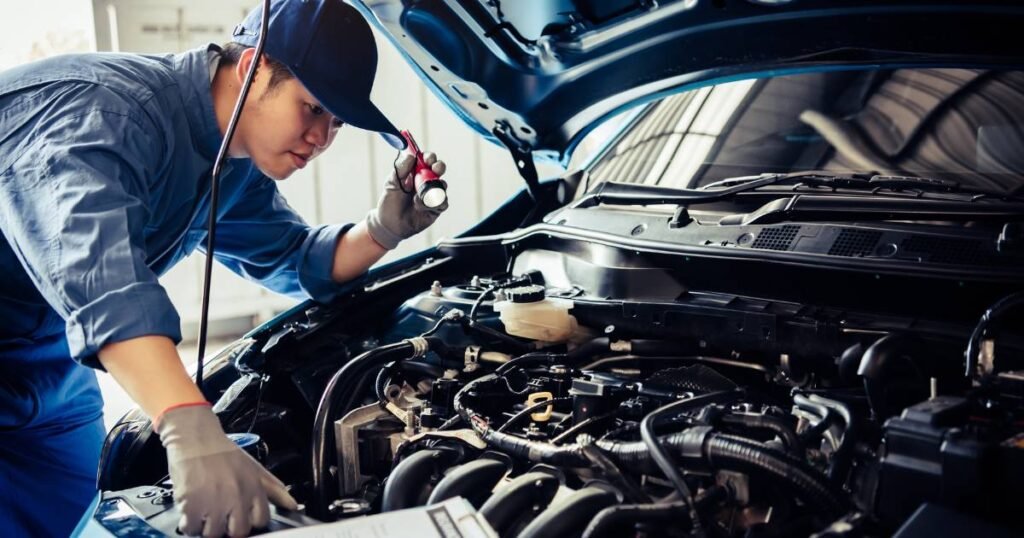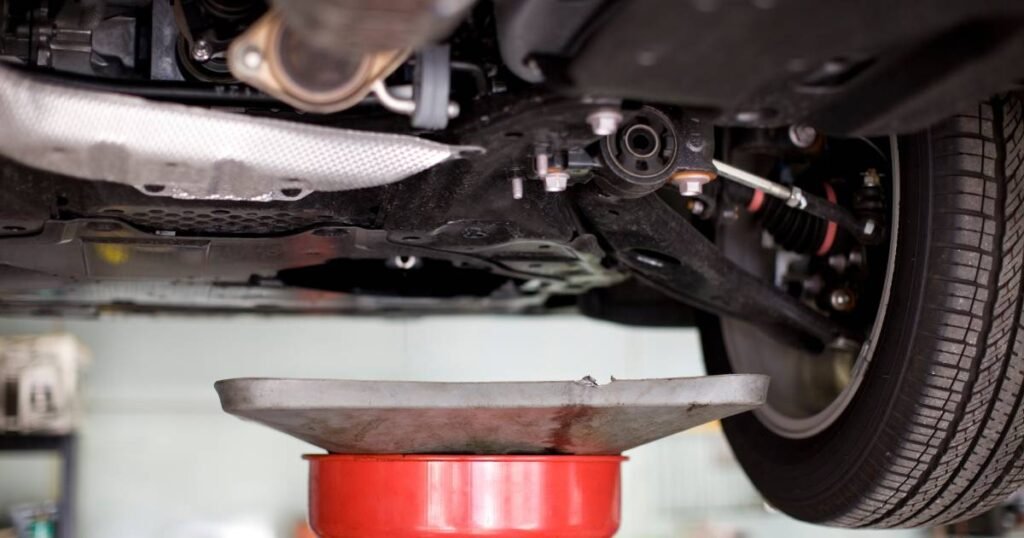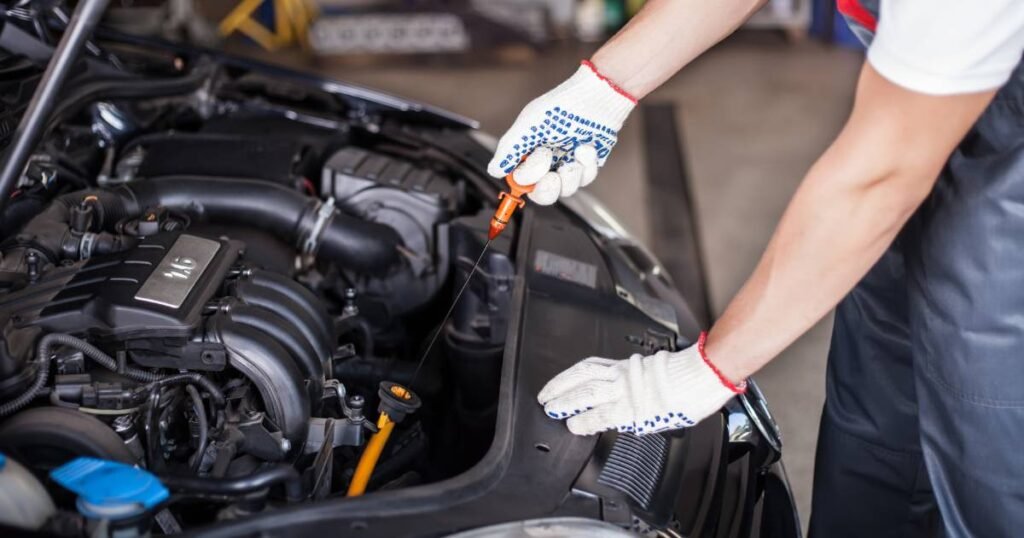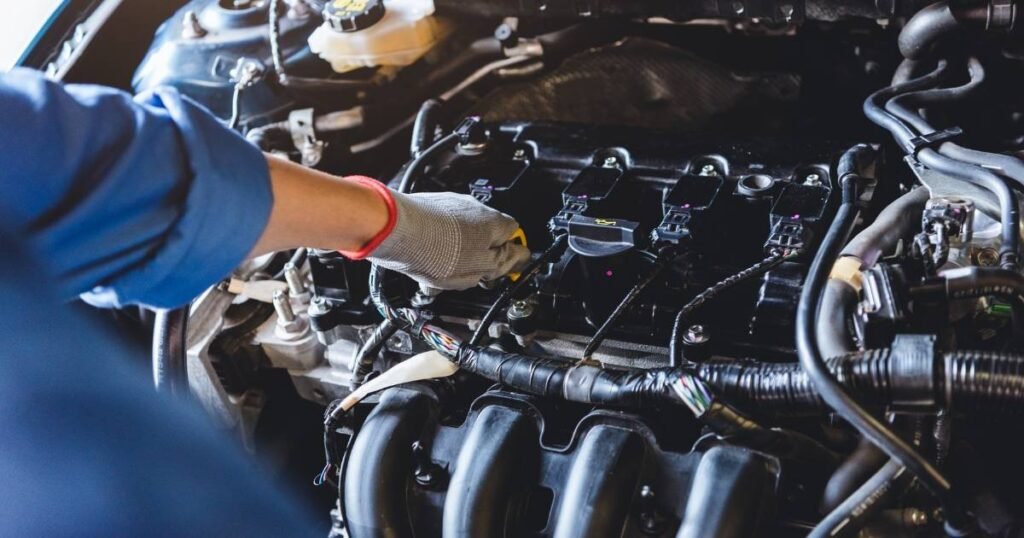Maintaining your vehicle’s optimal performance is important, and one key part is getting a full-service oil change. This isn’t just about changing the oil. It involves more detailed steps to keep your engine running smoothly and lasting longer.
In a full-service oil change, they don’t just drain and replace your oil. They also change the filter and check over other parts of your car. This helps catch any problems early, which can save you from bigger issues down the road.
It’s a thorough process that goes beyond the basics. This kind of care makes sure your car stays in great shape and helps avoid unexpected repairs. Remember, keeping up with regular oil changes is one of the best ways to keep your car working well for a long time.
Table of Contents
What is a Full-Service Oil Change?
Imagine your engine as a bustling metropolis – pistons and gears orchestrate a symphony of motion, generating immense heat and friction.
This is where oil steps in, acting as the city’s lifeblood. It lubricates moving parts, minimizing friction and wear, and regulates temperature, preventing damaging overheating.
Over time, however, oil loses its potency, becoming contaminated with debris and losing its viscosity. This is when a full-service oil change becomes your engine’s guardian angel.
What Makes a Full-Service Oil Change Different?
A full-service oil change goes beyond the routine oil and filter swap. It’s a multi-pronged approach that pampers your engine with a holistic care package:
- Oil Selection and Replacement: Expert technicians meticulously choose the right oil for your specific Land Rover model and engine, ensuring optimal performance and protection. The used oil and filter are then disposed of responsibly, minimizing environmental impact.
- Essential Fluid Top-Ups: Vital fluids like washer fluid, transmission fluid, and engine coolant are topped off to ensure smooth operation and system integrity.
- Thorough Inspection and Maintenance: A multi-point courtesy inspection is conducted, meticulously examining critical components like brakes, tires, belts, hoses, and undercarriage for any signs of wear or leaks. This proactive approach helps prevent minor issues from escalating into costly repairs.
- Lubrication and Fine-Tuning: Chassis components are lubricated to ensure smooth movement and prevent wear. Wiper blades and car batteries are checked for optimal functionality.
- Visual Damage Assessment: The technician performs a thorough visual inspection, identifying any potential damage to the vehicle’s exterior or undercarriage.
What Does A Full-Service Oil Change Consists Of?
A full-service oil change transcends the mere act of oil and filter replacement. It encompasses a meticulous multipoint inspection that delves into the vital systems that keep your engine purring smoothly. Here are the three main steps that could be involved in the full oil service:

Step One: Draining the Old, Embracing the New
The core of any oil change lies in replacing the aged oil, laden with contaminants, with fresh lubricant. This vital step involves:
- Draining the Used Oil: The technician expertly locates and removes the drain plug, allowing the old oil to flow. Gravity and a specialized suction pump ensure the complete removal, preventing residue buildup.
- Filter Replacement: The oil filter, responsible for trapping impurities, gets replaced simultaneously. Choosing the right filter for your vehicle’s specific make and model is crucial for optimal performance.
- Fresh Oil Injection: The mechanic injects the appropriate amount of new oil, following your manufacturer’s recommendations. High-quality oil selections like conventional and synthetic oil, synthetic blends, and high mileage cater to diverse engine needs. Consulting your owner’s manual for the recommended oil type is key.

Step Two: Beyond the Oil Pan – A Holistic Inspection
A full-service oil change goes far beyond just changing the oil. It’s a multi-point inspection that safeguards your vehicle’s health and identifies potential issues early on. Here’s what’s included:
- Air Filter Check: A clogged or dirty air filter hinders engine performance and fuel efficiency. Technicians assess its condition and recommend replacement if necessary.
- Coolant/Antifreeze Level Check: Maintaining proper coolant levels is vital for engine temperature regulation. Technicians check the coolant level and top it off with the manufacturer-recommended type, ensuring optimal engine function and corrosion prevention.
- Power Steering Fluid Check: Smooth steering relies on sufficient power steering fluid. Technicians verify the fluid level and top it off if needed, guaranteeing effortless maneuvering.
- Brake Fluid Check: Adequate brake fluid is crucial for safe stopping. Technicians assess the fluid level and add more if required, ensuring optimal braking performance and driver confidence.

Step Three: Optimizing Every Corner – A Symphony of Care
A full-service oil change delves deeper, addressing various aspects of your vehicle’s well-being:
- Chassis Lubrication: Modern vehicles might boast “lifetime lubricated” parts, but a technician’s check ensures optimal operation and identifies components needing lubrication.
- Wiper Blade Health Check: Worn wiper blades compromise visibility in harsh weather conditions. Technicians assess their condition and recommend replacement if necessary for clear and safe driving.
- Washer Fluid Level Check: A full reservoir of washer fluid is essential for maintaining clear vision on the road. Technicians top off the fluid, ensuring you’re prepared for unexpected splatters.
- Battery Check: Technicians test your battery’s health, identifying potential issues that could lead to starting problems. Early detection allows proactive maintenance, preventing inconvenient breakdowns.
See also: Does Walmart Install Car Batteries For Free?
Why Should You Get a Full Service?
A full-service oil change offers more than just the basics of replacing oil and a filter. It really helps your car in big ways. With clean oil and a good filter, your engine runs smoother. This means it doesn’t have to work as hard, which can help your car last longer.
When your engine runs smoothly, it also uses less fuel. This saves you money every time you fill up at the gas station. Plus, keeping your car in top shape means it could be worth more when you decide to sell it.
Knowing that your car is well taken care of gives you peace of mind. You can drive without worrying about sudden car troubles. Some car insurance companies even give discounts if your car is regularly serviced. This can make owning a car a bit cheaper for you.
What are the Different Service Options Available?
Taking care of your car is very important. An Interim Service is great for cars that drive a lot or for short trips. It happens every six months. In this service, we check the oil, brakes, and tire pressure.
A Major Service is the most complete check-up for your car. It’s best to do this every two years or follow what your car’s maker suggests. This service includes everything in the Full Service, plus more detailed checks on certain parts of the car.
How much does it cost for the full-service oil change?
Full-Service Oil Change Estimates:
General Cost Range:
- Conventional oil change: $35-$75
- Synthetic blend oil change: $65-$125
- Full synthetic oil change: $85-$150
Dealerships:
- Offers: Conventional and synthetic oil changes, tire rotations, and multi-point inspections.
- Cost: $50-$90
- Offers: Conventional and synthetic oil changes, tire rotations, and filter replacements.
- Cost: $45-$85
Ford:
- Offers: Conventional, synthetic blend, full synthetic oil changes, tire rotations, and battery checks.
- Cost: $40-$75
Chevrolet:
- Offers: Conventional and synthetic oil changes, tire rotations, and fluid top-offs.
- Cost: $35-$70
- Offers: Conventional, synthetic blend, full synthetic oil changes, tire rotations, and cabin air filter replacements.
- Cost: $55-$95
Auto Centers:
- Offers: Conventional and synthetic oil changes, tire rotations, and battery testing.
- Cost: $40-$80
- Offers: Conventional and synthetic oil changes, tire rotations, and wiper blade replacements.
- Cost: $35-$75
- Offers: Conventional, synthetic blend, full synthetic oil changes, tire rotations, brake checks.
- Cost: $50-$90
- Offers: Conventional and synthetic oil changes, tire rotations, and headlight adjustments.
- Cost: $45-$85
Tire Kingdom:
- Offers: Conventional and synthetic oil changes, tire rotations, and wheel alignments.
- Cost: $55-$95
Please note: These are just estimates, and the actual cost may vary depending on your specific car, the type of oil used, the location of the dealership or auto center, and any additional services you choose.
How long does it take for a full-service oil change?
The duration of a full-service oil change can vary based on several key factors. On average, if you visit a quick-lube shop, you can expect the service to take about 15 to 45 minutes. However, the process might take slightly longer at dealerships and auto centers, typically 30 to 60 minutes.
You also like reading this: How Long Does an Oil Change Take?
The complexity of your car can influence the time it takes. Some vehicles have oil pans or filters that are harder to access, which can add to the service time. Additionally, suppose you opt for a full service that includes not just an oil change but also tire rotations, filter replacements, or other checks. In that case, this will naturally extend the duration of the service.
Another factor to consider is the shop’s current workload. During busy periods, there may be longer wait times.
To help ensure a quicker service, scheduling your appointment in advance is advisable. Arriving early, especially during off-peak hours, can reduce your wait time. It’s a good idea to call ahead to confirm the estimated wait time so you can plan your visit accordingly.
Final Verdict
A full-service oil change is not merely a routine maintenance task; it’s an investment in your vehicle’s health and longevity. By opting for this comprehensive service, you ensure your engine operates at its peak, safeguard its future, and experience the joy of smooth, reliable performance for miles to come.
Relevant:
Is Engine Oil the Same as Oil Change?
How To Change an Oil Pan Gasket?
Why Is My Car Leaking Oil After an Oil Change?
Do You Need to Change Oil Filter Every Oil Change?
FAQs
What is the difference between a basic and a full-service oil change?
A basic oil change typically only involves draining the old oil, replacing the filter, and refilling it with new oil. A full-service oil change goes beyond this, including a multipoint inspection of vital fluids, tire pressure, undercarriage components, and battery health.
How often should I get a full-service oil change?
Consult your vehicle’s owner’s manual for the manufacturer’s recommended oil change interval. This can vary depending on your driving habits, type of oil used, and environmental factors.
What comes with a full oil change?
A full-service oil change involves draining and replacing the old oil to remove contaminants, ensuring the engine runs smoothly. We also replace the oil filter to keep the oil clean, add the correct type and amount of new oil for optimal engine performance, and check and top off other essential fluids like brake fluid, windshield washer fluid, and coolant. Additionally, technicians conduct a multi-point inspection of crucial components such as belts, hoses, tires, and lights, and adjust tire pressure to improve fuel efficiency and safety.
What is the difference between basic and full oil change?
A basic oil change involves draining and replacing the oil and filter. It’s the most essential service, but a full service offers more comprehensive care for your car.
What do they check during an oil change?
During a full-service oil change, technicians check several important components to ensure the car is in good condition. They inspect the engine and cabin air filters, assess the battery’s health, and examine the brake pads and rotors. Additionally, they check the wiper blades for effectiveness and verify that fluid levels, including brake fluid, coolant, and windshield washer fluid, are adequate. The tire tread depth and pressure are also evaluated, along with a thorough inspection of the undercarriage for any leaks or damage. This comprehensive check helps maintain the vehicle’s safety and efficiency.
Does a full service include gearbox oil?
Typically, no. Gearbox oil (also called transmission oil) is a different type of lubricant with a separate maintenance schedule. While some shops may offer a combined “full service” that includes engine and gearbox oil changes, it’s not standard practice. Consult your owner’s manual or the service center to confirm their offerings.


